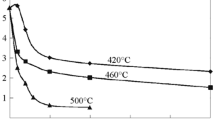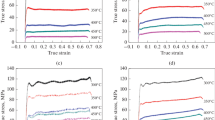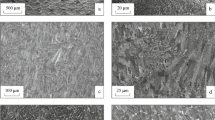The effect of heat treatment of aluminum alloy 01570 on the microstructure, phase composition and mechanical properties of an ingot at elevated temperatures is studied. An optimum mode of heat treatment raising the strength properties of alloy 01570 at good ductility in the range of elevated temperatures is suggested.
Similar content being viewed by others
Avoid common mistakes on your manuscript.
Introduction
Alloy 01570 belongs to commercial nonhardenable deformable medium-strength alloys of the Al – Mg – Mn system. Its process properties in the metallurgical production are close to those of AMg6. However, 01570 may be used for making semiproducts with higher strength characteristics and corrosion resistance and better weldability than alloy AMg6.
Hardening of alloys of the Al – Mg system due to low additives of scandium and zirconium is commensurable to the hardening due to the main component, i.e., magnesium. Annealed sheets from alloy AMg6 (6% Mg – 0.6% Mn) have a yield strength σ0.2 = 160 – 180 MPa; similar sheets from alloy 01570 (6% Mg – 0.4% Mn – 0.2% Sc – 0.1% Zr) have σ0.2 = 300 – 320 MPa, i.e., the low additives of scandium and zirconium almost double the yield strength. This allows us to speak of the Al – Mg – Sc – Zr system as a base one for not heat-hardenable alloys of a novel type [1].
Investigations of scandium alloying of 01570 are continued and promise further improvement of the properties, especially in the case of accelerated rates of cooling and crystallization, which permit elevation of the content of scandium in the alloys in question [2]. Scandium has first been used as an alloying element for aluminum alloys in the 1980s and turned out to be the most effective of the known alloying elements. Precipitates of phase Al3Sc are much finer (1 – 10 nm) than precipitates of Mn and Zr aluminides. Introduced in an amount of 0.15 – 0.25% scandium provides high precipitation hardening in the ingots at correctly chosen temperature regimes of their treatment. The hardening of deformed semiproducts from aluminum alloys due to Mn, Zr and Cr additives is largely determined by the formation of a subgrain structure in them and is less dependent on the precipitation hardening; the hardening due to scandium additives, for example, in the alloys of the Al – Mg system depends on both these factors. In addition, the alloys of the Al – Mg and Al – Zn – Mg systems with a scandium additive, especially when it is introduced together with zirconium, exhibit hardening after a heat treatment in all deformed semiproducts including strongly cold-deformed sheets [3, 4]. The Al3Sc intermetallics possess a crystal structure of type L12 with lattice constant differing by only 1.34% from the lattice constant of aluminum at 24°C. By varying the proportion of Sc and aluminum in the alloy we can attain full correspondence between the Al3Sc intermetallics with L12-type structure and the aluminum matrix [5]. The addition of zirconium raises the strength characteristics and the resistance to recrystallization of the alloy due to formation of Al3(Sc, Zr) aluminides.
The strength and ductility characteristics, the resistance to crack nucleation and propagation under static and cyclic loads of aluminum alloy 01570 exceed the similar parameters of many aluminum alloys [6]. If we take into account that the corrosion resistance and the weldability of the alloy are quite high, we will see that it promises much for the aircraft industry. Most attention in the production of aircrafts is devoted to lowering the weight and raising the endurance of the parts. For this reason, elevation of the strength of the materials used is very important for raising the reliability of the articles [7].
The operating characteristics can be improved by providing the specified microstructure and properties [8]. Heat treatment (HT) is one of the methods used for the purpose. Advancement of the process of production of articles from alloy 01570 makes researchers study the effect of HT modes on the microstructure, mechanical and casting properties of the alloy [9].
Severe plastic deformation of articles from alloy 01570 has become a subject of relatively many recent studies. In addition to solid solution hardening, this method provides structural hardening due to formation of grains less than 1000 nm in size and a developed substructure and elevation of the dislocation density. The coherent particles of Al3(Sc, Zr) present in the alloy prevent intense creep and annihilation of dislocations and migration of boundaries thus making the forming structure more thermally stable [10–12]. Investigation of the influence of HT of ingots from alloy 01570 on the mechanical properties at elevated temperatures is also important for advancing the processes of severe plastic deformation.
The aim of the present work was to study the effect of heat treatment of alloy 01570 on the microstructure, phase composition and mechanical properties of ingots at elevated temperatures.
Methods of Study
We studied ingots of aluminum alloy 01570 with cross section 400 × 1600 mm obtained by semi-continuous casting. The chemical composition of the alloy is presented in Table 1. The ingots were heat treated for raising their strength at preserved good ductility in the range of elevated temperatures.
To determine the appropriate mode of heat treatment and estimate the conditions for irreversible changes in the structure and mechanical properties of alloy 01570 we studied five batches of ingots (Table 2).
We determined the temperature dependences of the ultimate strength, of the conventional yield strength and of the ductility at elevated temperatures (340 – 470°C). The mechanical tests were performed by the standard methods at the “KUMZ” Company.
The microstructure of the ingots of alloy 01570 was studied by the methods of quantitative metallography and x-ray phase analysis using a JSM-5900 LV scanning electron microscope. The microscopic x-ray spectrum analysis (MXRSA) of the phase components of an ingot was conducted with 5% relative error of the determination of the content of the chemical elements (contained in the metal in an amount of less than 10%) and 1% relative error for the chemical elements with over 10% concentration.
Results and Discussion
We studied the microstructure of cast specimens of alloy 01570 after different modes of HT (Table 2). The microstructure of all the castings had a well manifested dendritic pattern; the crystallization developed by a cellular-dendritic mechanism (see Figs. 1 and 2). After the HT the microstructure of the alloy changed. In particular, this concerned the composition and the content of the intermetallics decorating the grain boundaries. The elements composing the bodies of grains and the compositions of the intermetallics decorating the grain boundaries depended on the HT of the ingot (Table 3). Upon increase in the homogenization temperature of the ingot to 500°C the element composition in the body of grains acquires zirconium in an amount of 0.1 wt.%. The microstructure of the not heat treated specimen bears crystals of Al3Mg2, Al6 (Mn, Fe) and Al3(Sc, Zr) intermetallics over grain boundaries; after the heat treatment the Al3Mg2 intermetallic disappears. The HT by variants 2 and 3 yields an Al3Sc phase over grain boundaries (Fig. 2). The presence of Al6(Mn, Fe) and Al3(Sc, Zr) intermetallics over grain boundaries has been detected in all the ingots studied. Amixture of Al2O3, MgAl2O4, MgO, and SiO2 oxides (the black layers in the photographs of the microstructures) has also been detected over grain boundaries. Heat treatment of the ingots lowers the content of oxides on their grain boundaries.
We tested specimens of ingots of alloy 01570 after different modes of HT (Table 2) and determined the temperature dependences of the ultimate strength, the conventional yield strength, the elongation, and the contraction at 340 – 470°C. The results of the measurements are presented in Fig. 3; their analysis is presented in Table 4.
With growth of the HT temperature from 445 to 530°C the ductility parameters in the test range t test = 340 – 470°C increase to different degrees. Prolongation of the time of the homogenization virtually does not affect the situation. It should be noted that the decrease in the ultimate strength and the yield strength is virtually the same (about 70%) for the studied range of the HT temperatures, while the growth in the ductility characteristics differs substantially (Table 4). The resulting combination of properties is optimum after the treatment by variant 1, i.e., 445°C for 8 h.
Conclusions
1. The element composition of grains and the composition of the intermetallics decorating grain boundaries depend on the mode of heat treatment (HT) applied to the ingots of aluminum alloy 01750. Growth in the HT temperature to 500°C is accompanied by the appearance of 0.1 wt.% zirconium in grain bodies.
2. The microstructure of the ingot of alloy 01570 not subjected to HT (initial condition) bears crystals of Al3Mg2, Al6(Mn, Fe) and Al3(Sc, Zr) intermetallics on grain boundaries. After the HT the Al3Mg2 intermetallic disappears; after the treatment at 500°C and higher temperatures an Al3Sc phase appears on grain boundaries. The presence of Al6(Mn, Fe) and Al3(Sc, Zr) crystals over grain boundaries is detected after all the tested variants of HT.
3. Growth in the test temperature from 340 to 470°C lowers the strength characteristics of alloy 01570 by about 70% whatever the treatment mode. The ductility characteristics increase differently; in the specimen without HT the increase in the elongation is the lowest (5%), whereas in the specimen after the HT at 445°C for 8 h the increase in the elongation is the highest (31%).
References
V. I. Elagin, “Ways to advance high-strength refractory structural aluminum alloys in the XXI century,” Metalloved. Term. Obrab. Met., No. 9, 3 – 11 (2007).
V. V. Zakharov and T. D. Rostova, “Effect of scandium, transition metals and impurities on hardening of aluminum alloys under decomposition of solid solution,” Metalloved. Term. Obrab. Met., No. 9, 12 – 19 (2007).
R. Z. Valiev and I. V. Aleksandrov, Bulk Nanostructured Metallic Materials: Fabrication, Structure and Properties [in Russian], IKTz “Akademkniga,” Moscow (2007),398 p.
N. A. Belov, Phase Composition of Commercial and Perspective Aluminum Alloys [in Russian], MISiS, Moscow (2010),511 p.
Gao Ying-jun, Ban Dong-mei, Han Yong-jian, et al., “Atomic bonding and mechanical properties of Al – Mg – Zr – Sc alloy,” Trans. Nonferr. Met. Soc. China, 14(5), 922 – 927 (2004).
C. B. Fuller, D. N. Seidman, D. C. Dunand, “Mechanical properties of Al(Sc, Zr) alloys at ambient and elevated temperatures,” Acta Mater., 51, 4803 – 4814 (2003).
J. E. Hatch (ed.), Aluminum: Properties and Physical Metallurgy [Russian translation], Metallurgiya, Moscow (1989), 422 p.
V. S. Zolotarevskii and N. A. Belov, The Physical Metallurgy of Castable Aluminum Alloys [in Russian], MISiS, Moscow (2005), 376 p.
V. D. Belov and V. A. Semenov, “Effect of magnesium and casting temperature on the structure, mechanical and casting properties of an alloy of the Al – Mg system,” Izv. Vysh. Uchebn. Zaved., Tsvetn. Met., No. 2, 41 (2004).
V. N. Perevezentsev, M. Yu. Shcherban’, M. Yu. Murashev, and R. Z. Valiev, “High-rate superplasticity of nanocrystalline aluminum alloy 1570,” Pis’ma Zh. Teor. Fiz., 33(15), 40 – 46 (2007).
W. Ozgowicz, E. Kalinowska-Ozgowicz, A. Kowalski, and K. Golombek, “The structure and mechanical properties of Al – Mg – Mn alloys shaped in the process of thermomechanical treatment,” J. Achiev. Mater. Manuf. Eng., 45(2), 148 – 156 (2011).
V. Radmilovic, A. Tolley, Z. Lee, and U. Dahmen, “Core-shell structures and precipitation kinetics of Al3(Sc, Zr)Li2 intermetallic phase in Al-rich alloy,” Metallurgija – J. Metall., 12(4), 309 – 314 (2006).
Author information
Authors and Affiliations
Corresponding author
Additional information
Translated from Metallovedenie i Termicheskaya Obrabotka Metallov, No. 4, pp. 18 – 22, April, 2016.
Rights and permissions
About this article
Cite this article
Reznik, P.L., Chikova, O.A. & Ovsyannikov, B.V. Effect of Modes of Homogenization of Ingots on the Microstructure, Phase Composition and Mechanical Properties of Alloy 01570 at Elevated Temperatures. Met Sci Heat Treat 58, 202–208 (2016). https://doi.org/10.1007/s11041-016-9989-4
Published:
Issue Date:
DOI: https://doi.org/10.1007/s11041-016-9989-4







